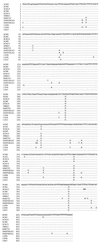Documenting the epidemiologic patterns of polyomaviruses in human populations by studying their presence in urban sewage
- PMID: 10618230
- PMCID: PMC91812
- DOI: 10.1128/AEM.66.1.238-245.2000
Documenting the epidemiologic patterns of polyomaviruses in human populations by studying their presence in urban sewage
Abstract
This is the first description, to our knowledge, of the distribution of human polyomavirus and simian virus 40 (SV40) in urban sewage. Using a nested-PCR procedure, we report the detection of human polyomaviruses JC virus (JCV) and BK virus (BKV) but not SV40 in a high percentage of urban sewage samples obtained from widely divergent geographical areas in Europe and Africa. For a total of 28 samples analyzed, JCV was detected in 26, BKV was detected in 22, and none was positive for SV40. All geographical areas showed a high prevalence of these viruses with mean estimated values of JC viral particles per ml on the order of 10(3) in Barcelona (Spain) and Nancy (France) and 10(2) in Pretoria (South Africa) and Umeå (Sweden) and mean values of BK viral particles on the order of 10(2) in Pretoria and Barcelona and 10(1) in Nancy and Umeå. This compares with estimated mean values of 10(2) to 10(3) for human adenovirus that was evaluated as a control. Nucleotide sequence analysis of the amplified DNA from some of the samples is also presented and represents the sequence of the most abundant JC and BK viral strains in these samples. The nucleotide sequence of the JCV detected was also analyzed in a phylogenetic study and for genomic characterization in the regulatory region. This study has shown that human polyomaviruses are spread in high concentrations in the sewage of different geographical areas and are present in contaminated environments. The frequency and concentration of JCV detected in the environment and the absence of described animal hosts suggest that JCV may be useful as a marker for fecal pollution of anthropogenic origin. The results also support the idea previously described that the strains of JCV are closely related to the ethnic origin of the population studied. The procedure applied should also be useful in future studies of population patterns of viral excretion and as a tool in epidemiological studies for the detection of changes in the prevalence of specific viral pathogens.
Figures





References
-
- Agostini H T, Ryschkewitsch C F, Brubaker G R, Shao J, Stoner G L. Five complete genomes of JC virus type 3 from Africans and African Americans. Arch Virol. 1997;142:637–655. - PubMed
-
- Agostini H T, Ryschkewitsch C F, Stoner G L. JC virus type 1 has multiple subtypes; three new complete genomes. J Gen Virol. 1998;79:801–805. - PubMed
-
- Agostini H T, Shishido-Hara Y, Baumhefner R W, Singer E J, Ryschkewitsch C F, Stoner G L. JC virus type 2: definition of subtypes based on DNA sequence analysis of ten complete genomes. J Virol. 1998;79:1143–1151. - PubMed
Publication types
MeSH terms
Substances
Associated data
- Actions
- Actions
- Actions
- Actions
- Actions
- Actions
- Actions
- Actions
- Actions
- Actions
- Actions
- Actions
- Actions
- Actions
- Actions
- Actions
- Actions
- Actions
- Actions
- Actions
Grants and funding
LinkOut - more resources
Full Text Sources

